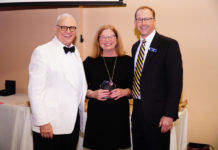 The average Jesuit student writes three to four research papers in his career, with each paper taking around a week of solid work. Junior Payton Maher’s series on Jesuit integration in the 1950’s, written exclusively for The Roundup, entailed a much deeper and more comprehensive research process than a garden-variety research paper.
The average Jesuit student writes three to four research papers in his career, with each paper taking around a week of solid work. Junior Payton Maher’s series on Jesuit integration in the 1950’s, written exclusively for The Roundup, entailed a much deeper and more comprehensive research process than a garden-variety research paper.
So comprehensive is his work, in fact, that it took six months of research and intensive editing to construct his 24-page piece, which is broken up into a three-part series.
The Roundup moderators Michael Degen and Sheryl Row approached Maher in June of 2011 about taking on the story. Row, who also heads Jesuit’s archives, knew the incredible story of Jesuit’s 1955 integration and suggested that the paper should cover it. “I was first approached at our meeting at Burger House last summer,” remembered Maher. “I had no idea Jesuit was the first [school] to integrate in Dallas.”
Over the rest of the summer, Maher worked with Degen and Row to construct an outline for the series. After the decision was made to break the story up into three pieces, Maher and The Roundup staff began collecting source material from the 1950s for the story.
For the next four months, Maher spent an inordinate amount of time researching the subject of integration. He, along with other members of The Roundup staff, poured over thousands of primary-source documents, including letters between Dallas civic leaders, official Jesuit statements, and The Dallas Morning News articles from the 1950’s.
Jesuit’s aforementioned archives, largely organized and maintained by Ms. Row, proved to be a huge asset at Maher’s disposal. “The archives gave me most of my starting research and gave [the series] a jumping off point,” said Maher. With the base plan for the series laid out, Maher began collecting research from outside sources. On a Saturday in September, Maher visited the J. Erik Johnson Central Library in downtown Dallas, where he perused “hundreds” of old newspaper clippings in search of mentions of Jesuit.
After compiling the loads of source materials and distilling down the main information, Payton began writing the three installments of his series, which highlight the racial tension in the United States and in Dallas. His articles received extensive suggestions for revision by both Dr. Degen and his uncle Dan Maher ’68, a former editor-in-chief of The Roundup and the winner of the 1996 Jesuit Distinguished Alumnus of the Year. “They gave me copious amounts of suggestions,” said Maher. “Their input helped me fine-tune my article.”
For the series, Maher interviewed a number of 1950’s contemporaries, including former Jesuit priests and teacher Jack Eifert, who joined the staff in 1956, the semester after Jesuit integrated. But the most consequential interview in the series came in December, when Maher and the staff traveled to St. Louis to interview Charlie Edmund ’58, the first black student to graduate from Jesuit.
Check out Payton’s upcoming series on The Roundup’s website for the incredible story of Jesuit’s integration. Part I will appear on Martin Luther King Day. Parts II and III will follow in weekly succession.






